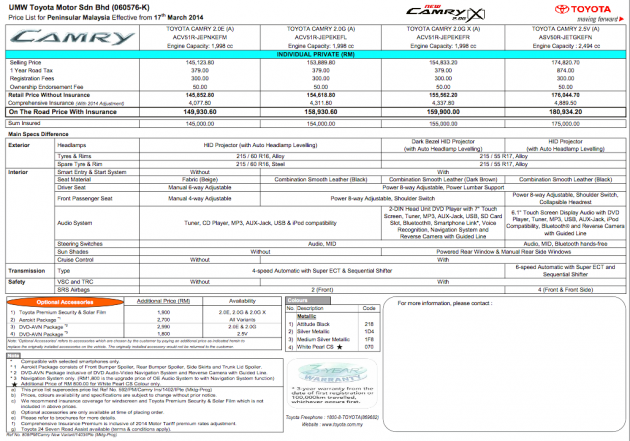Toyota Malaysia has very sneakily published first details of a new Camry variant, the Toyota Camry 2.0 G X, on its website. The new trim level is an attempt to add more value to the 2.0 G variant.
Not many details are known at the moment – we only have this interior picture to go on so far – but the main differences on the exterior are 17-inch dark silver alloy wheels (shod with 215/55 tyres, just like the 2.5 variant) as well as dark bezel HID projector headlights and LED tail lights for the “smoked” look.
Inside though is where most of the changes lie. The upholstery is now dark brown leather and there is what looks like a unique wood trim design. Also new is a 2-DIN head unit with a seven-inch touchscreen, DVD player, Bluetooth, Smartphone Link, navigation and a reverse camera with guide lines. In addition, the 2.0 G X variant gets the powered rear blind and manual rear side window blinds from the 2.5.
The price of the 2.0 G X as stated on the price list is RM159,900, on the road with insurance. That is just shy of a RM1,000 premium over the 2.0 G, but much cheaper than the 2.5 V.
Read our review of the Toyota Camry 2.5 V here, and check out Episode 5 of our Driven Web Series, where we pit the Camry against the Honda Accord and Mazda 6 in our company car shootout.
Looking to sell your car? Sell it with Carro.






























AI-generated Summary ✨
Comments mostly express disappointment with the Toyota Camry 2.0 G X, criticizing its outdated 4-speed automatic transmission, high price, and lack of features like VSC and more airbags, making it less competitive against rivals like Accord, Mazda6, and Teana. Some highlight the Camry's reliability and brand value despite negative reviews, while others believe UMW's pricing and marketing strategies are flawed, leading to declining sales and market share. There are comparisons with second-hand models that suggest significant depreciation. While some supporters praise Toyota for its durability and resale value, many clearly prefer alternative models offering better features and value for money. Overall, sentiments lean toward dissatisfaction with the new model's value and relevance in the current market landscape.